
Facebook Twitter Instagram YouTube RSS Feed
Written on: May 15th, 2020 in Beneficial Use
Guest writers: Ashley Norton & Sierra Davis, DNREC Shoreline & Waterway Section
The Shoreline & Waterway Section (SWMS) manages 27 channels in all 3 counties of the State of Delaware. SWMS collaborates with WMAP to find creative and beneficial ways to use sediment dredged from waterways for ecological restoration projects (as in the Piney Point Marsh Restoration/Beneficial Use project).
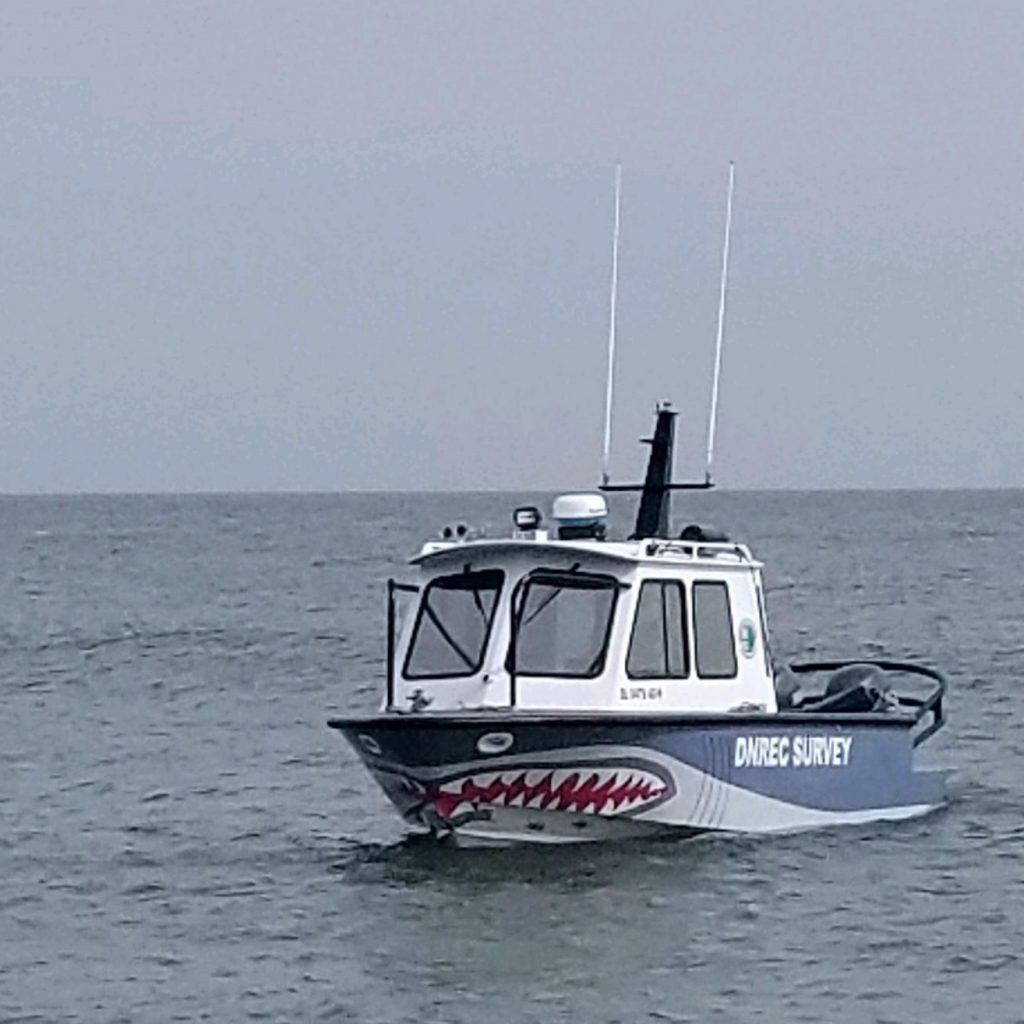
You may have seen our survey vessel and survey crew out on the water here in Delaware. This 25-foot vessel is equipped with a GPS, a sonar system to measure the depth of channels, and software used for navigation, data collection, and processing.
The sonar system on board functions like a scientific version of fish finders that you might have on your boat. The time the sound signal takes to travel from the vessel to the channel bottom and back up to the sonar’s receiver, is used to derive depth measurements. The ship’s position and motion are also incorporated and corrected for when calculating depth.
The surveys are used to determine locations to place channel markers that aid in navigation, locate and measure sediment shoals in waterways, and help with the design of dredging projects.
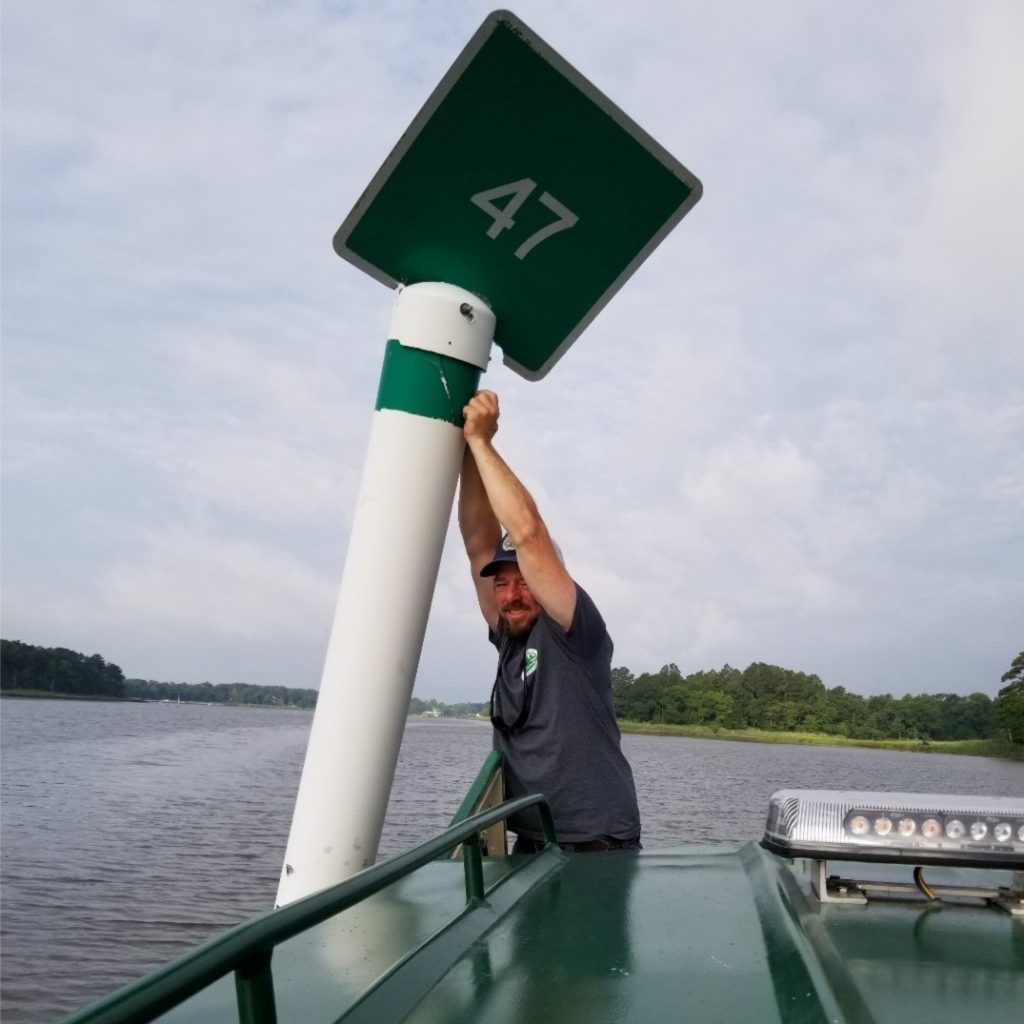
We have been marking navigational channels in Delaware’s Inland Bays since 1996. Our Section has a cooperative agreement with the United States Coast Guard to establish aids to navigation in the State’s Inland Bays channels not marked by the Coast Guard. We supplement Coast Guard markers with lighted buoys as well as PVC-pipe daybeacons.
Currently, the Section maintains almost 200 markers. Daybeacons and buoys are checked before the start of each boating season and, if needed, replaced by the Section’s channel marking crew.
Our staff on the channel marking crew are experts in working in tidal environments and using the equipment needed to place markers. We own and maintain equipment including: vessels, a hydraulic excavator, and a sectional barge – all of which are used to place the channel markers. This typically takes a 3 to 4-person team.
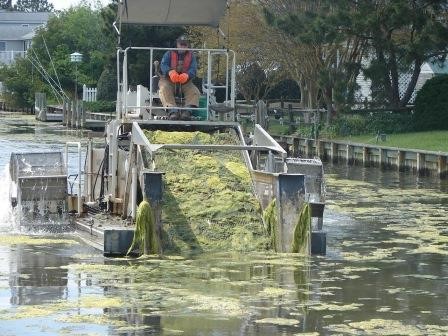
Macroalgae has become more prevalent in parts of the Inland Bays over the years as a response to increased nutrients in waterways. These nutrients come from runoff from adjacent residential and agriculture lands or domestic septic systems.
This program aims to protect, preserve, and restore natural resources in Delaware waterways by removing the excess algae growth that can become an environmental concern and cause harm.
Our Section has the capacity to operate two unique macro-algae harvesters. Harvesting helps manage large amounts of macroscopic algae located in nearshore areas. Macroscopic algae are algae you can see with the human eye, such as Ulva (or Sea lettuce).
Our Section coordinates with DNREC’s Division of Fish and Wildlife when scheduling and planning harvesting to minimize potential by-catch, such as fish, during operations.
Harvesting beneficial Submerged Aquatic Vegetation such as wigeon grass and eelgrass, is avoided because this type of growth provides good nursery habitat for aquatic species and helps to stabilize sediments.
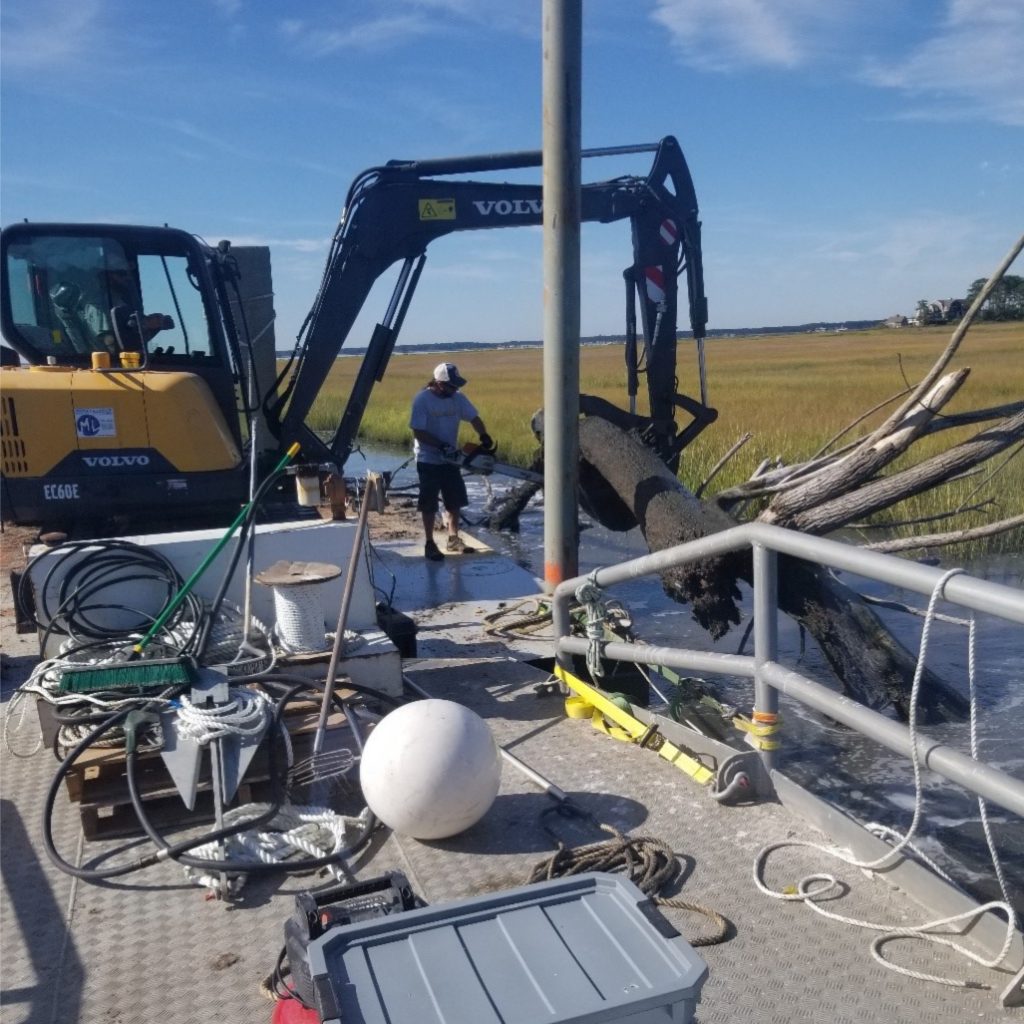
The Section owns and operates a work barge, a hydraulic excavator, and various outboard boat motors that enhance our ability to keep the state’s navigable waterways open and safe.
This equipment is used to remove abandoned vessels and derelict structures from state-maintained publicly-accessible waterways. Derelict structures might include: downed trees, ship wrecks, pilings, misplaced navigational aids, or large items of trash.
Dredging is the process of removing sediment and other material from the bottom of waterways to improve navigation. Dredging in Delaware is unique because we have a state Dredge Program that has the ability to conduct small-scale dredging operations in-house, in addition to coordinating and planning large-scale contractual operations with outside contractors.
The state currently operates two dredges that are engineered to maintain smaller waterway resources such as: channel segments, boat ramps, marinas, and state-owned lakes and ponds. In-house dredging projects include: the removal of sediment from public marina boat slips, maintaining public boat ramp depths, dredging state-owned ponds, and dredging smaller segments of channels.
Commercial dredge companies work 7 days a week around the clock and use equipment designed for removing sizeable quantities of sediment and pumping far distances for disposal. Because of this, contractual dredging is used for large-scale dredging projects in Delaware, such as the Massey’s Ditch project.
How do we decide where to dredge? We collect data and talk to our stakeholders – not only other government agencies but also the public – boaters like you! NOAA Coastal Management Fellow Sierra Davis collected a ton of data and feedback about our waterways, and has given the SWMS a way to prioritize future dredging projects. Check out her project here!
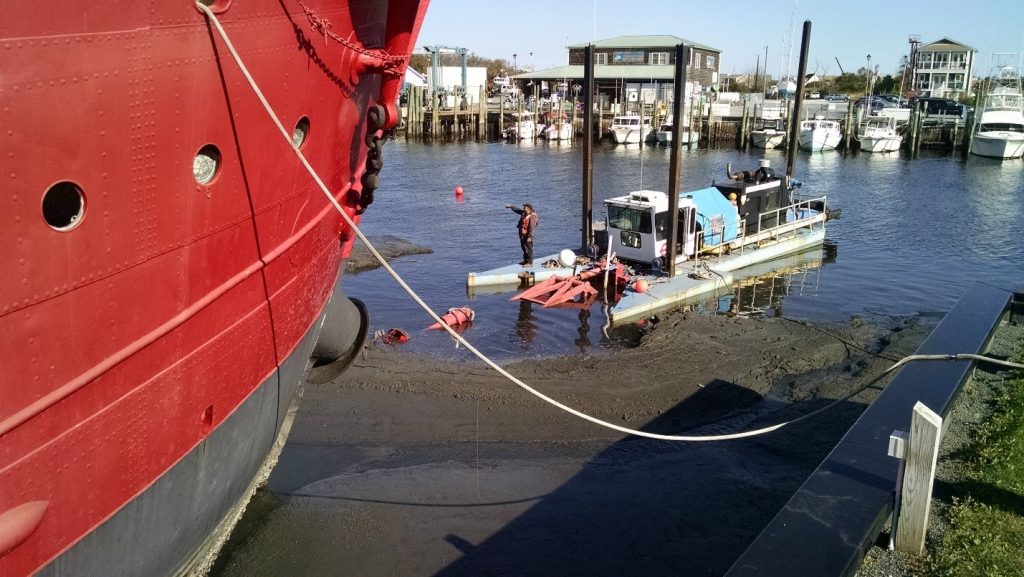
Permits are needed for dredging in Delaware. Each project must consider possible environmental effects of dredging on fisheries, water quality, and the benthic (or channel-bottom) environment.
To protect vulnerable species, dredging operations are often limited to specific months during the year. In Delaware, these environmental windows allow for dredging only in the fall and winter months. Additionally, sediment is tested before dredging begins to determine the grain size, color and presence of any contaminants to make sure that the dredging process does not stir up anything bad.
This process helps determine where sediment can be placed once dredged and that sediment can be disposed of safely. For example, if the sediment is determined to be coarse and sandy and free of contaminants, it might be beneficially used for beach nourishment.
Dredged sediment is often placed in Upland Confined Disposal Facilities (CDFs) which are diked areas of land designed to hold and safely de-water dredged sediment. The number of CDFs in Delaware has decreased over time due to facility capacity and development of upland areas as people realize the appeal of living on the water in the Inland Bays.
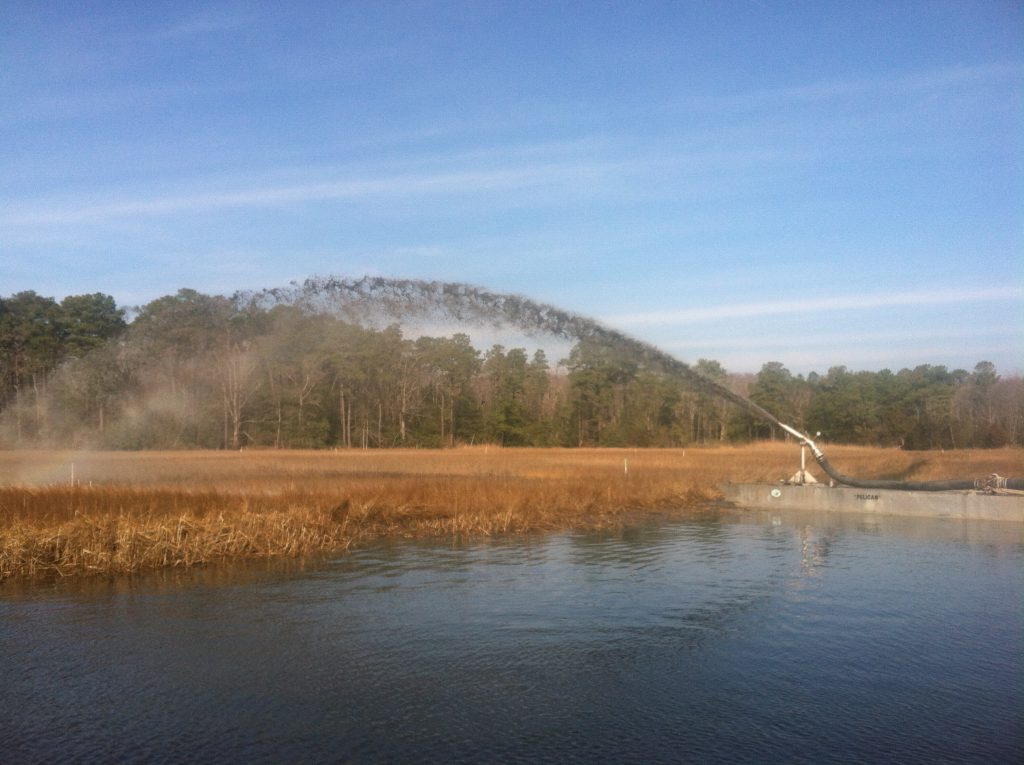
Whenever possible, it is ideal to use the sediments from a dredge project for a restoration project. Beneficial use of dredged sediment is becoming a necessary management strategy as the number of CDFs decline. Sediments themselves are also a resource and dredging practitioners such as SWMS are trying to increasingly collaborate with restoration practitioners such as WMAP to make the best use of that resource.
When dredged sediments meet certain testing standards (grain size, contaminant, color, among other testing), there can be ecological restoration opportunities that use the dredged material. These projects might include using the sediment to stabilize a shoreline, nourish a beach (such as the 2020 Massey’s Ditch project), restore an eroded marsh area, or help to protect a marsh from sea level rise (such as in the Piney Point project). With increased understanding of the environmental and restoration needs, beneficial use is regionally becoming a popular sediment management tool.
Written on: May 13th, 2020 in Outreach

Guest writer: Maggie Pletta, DNREC Division of Climate, Coastal & Energy
Delaware is known for its ability to tackle complex problems by bringing its residents together to work out solutions. Among this year’s problems: planning how the state will respond to climate change.
The impacts of climate change vary around the globe, but in Delaware, the changes we are already experiencing include increased temperatures and rising sea levels. These impacts are expected to continue or worsen. Moreover, climate scientists anticipate precipitation patterns will also change, with more frequent intense storms hitting the state. These changes will have major impacts on human health and safety, our natural resources (like wetlands), agriculture, and transportation infrastructure.
The annual average temperature in Delaware has risen 2 degrees since 1900, and the best available science projects that by 2050, the average temperature in the state will be between 2.5 and 4.5 degrees warmer than it is today. Increased temperatures directly threaten human health in a variety of ways including heat rash, heat cramps, heat exhaustion, and heat stroke. All can aggravate underlying health conditions and cause the heart, kidneys, lungs, and other internal organs to fail. But human health is not the only thing impacted by high temperature; roadways can also heave and buckle during heat waves, damaging critical infrastructure.
Records at the Lewes tide gauge indicate that sea level has risen more than a foot over the last century and are projected to rise an additional 9 to 23 inches by 2050. As sea level continues to increase a variety of impacts occur, most notably flood damage to habitats, roads, and infrastructures located in low-lying areas. Other impacts include increased erosion rates and saltwater intrusion in coastal soil and water resources that can render them unusable for agriculture and drinking water.
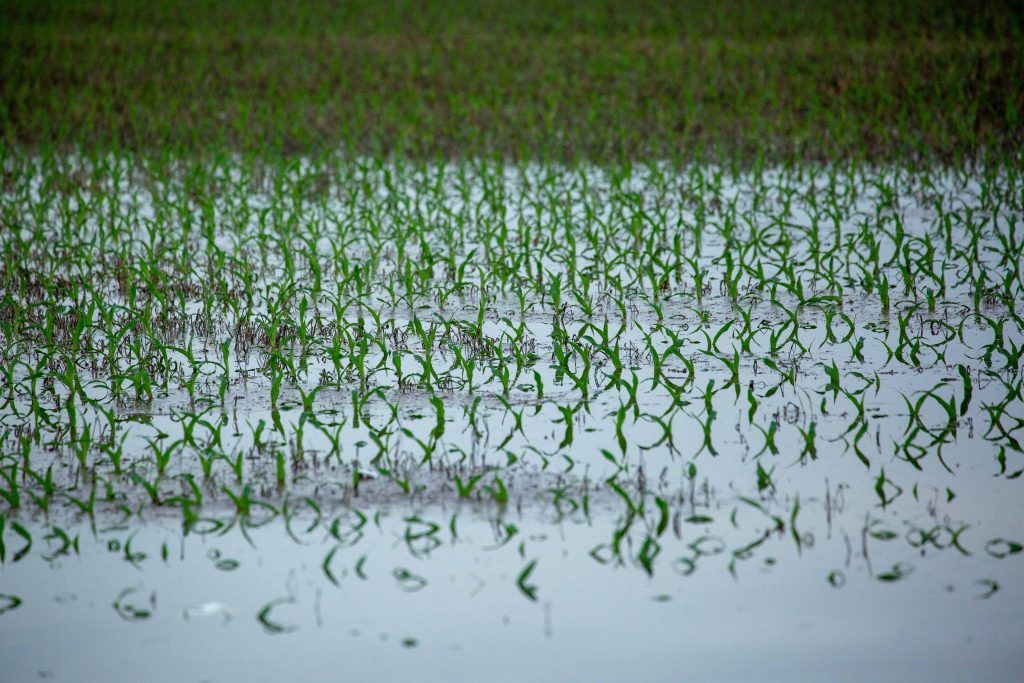
While the most recent climate trends do not show an increase in precipitation and extreme weather events, it is projected there will be noticeable changes in the future. It is projected there will be a 5% increase in average yearly precipitation and increased frequency and intensity of extreme weather events by 2050 and a 10% increase in precipitation amounts by century’s end. Changes in precipitation, including extreme rainfall events, will affect agriculture by damaging crops, altering growing seasons, and increasing crop disease pressure.
Over the course of 2020, the state is working to create the Delaware’s Climate Action Plan, a framework for how Delaware can address the causes and consequences of climate change in the decades ahead. The plan will build on years of research, plans, and commitments, such as the state’s sea level rise planning process and Delaware’s participation in the Regional Greenhouse Gas Initiative and the U.S. Climate Alliance.
The plan will map out actions to reduce greenhouse gas emissions from various economic sectors, including transportation, industry, and energy production — the three leading greenhouse gas emitters in the state.
Additionally, the plan will lay out the actions state agencies can take to support the state in adapting to climate change. These actions will be shaped by the best adaptation practices from across the world.
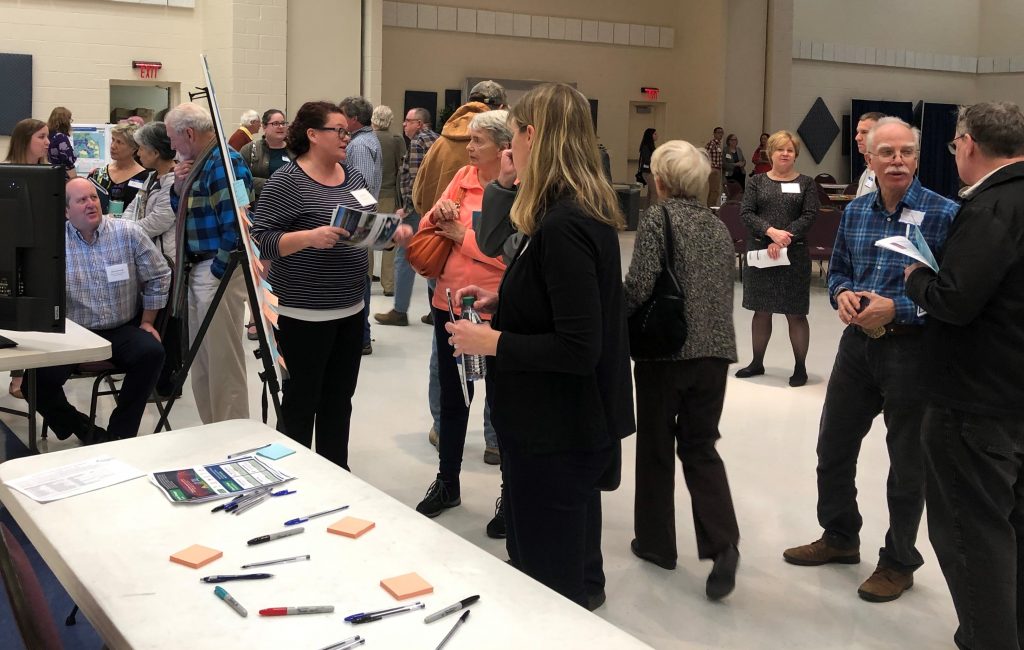
In developing Delaware’s Climate Action Plan, DNREC’s Division of Climate, Coastal & Energy (DCCE) hosted three public workshops in early March to learn of Delawareans’ experience with climate impacts and to gather input on how the state can best address the causes and consequences of climate change. More than 250 people attended the workshops.
The Division also held a technical advisory workshop in March with representatives from the transportation, buildings, energy, and industrial sectors to solicit ideas for reducing greenhouse gas emissions. Summary reports for the public and technical advisory workshops will be posted in the coming weeks on declimateplan.org.
DCCE’s Climate Action Plan team is continuing to shape the plan during these unprecedented times, working with technical consultants to put together a comprehensive greenhouse gas analysis that will examine which statewide strategies may be most effective in reducing the state’s carbon footprint.
The Climate Action Plan team is also actively engaging with stakeholders from across DNREC and other state agencies to identify possible adaptation actions these agencies can take as part of the final plan. These ideas for adaptation actions will be presented to the public later this year for feedback. Details on how to provide feedback will be posted online at declimateplan.org, on our Facebook and Twitter, and via the DCCE Newsletter.
For the plan to be successful, we need to hear from you, on what actions you want the state to take to address climate change.
You can provide feedback and your input in a variety of ways:
Also, be sure to follow our project website at declimateplan.org or our Facebook and Twitter pages for the most up-to-date information. With your feedback and support, we aim to create a plan that shapes a future where individuals, businesses, communities, and institutions can deal with extreme weather, harness clean energy, breathe fresh air, and live healthier lives.
Written on: May 13th, 2020 in Living Shorelines, Outreach, Wetland Restorations
Guest writer Andrew Bell, DNREC Shellfish & Recreational Water Program
At first glance, an oyster appears to be little more than, well, a bit of goo inside a rock. But actually, the humble oyster is an environmental warrior with an impressive bag of tricks up its sleeve, and it serves as a keystone species upon which depends the health of a marine ecosystem and the surrounding marsh.
Oysters provide numerous essential ecosystem services to waterbodies and wetlands.
Let’s learn more about each of these three environmental services provided by the amazing oyster.
The most obvious of the oyster’s multiple roles in Mother Nature’s army is as a water filter. Oysters eat by pumping the surrounding water through their bodies, removing from the water bits of food along with harmful excess sediments and nutrients. A single oyster can filter up to fifty gallons of water per day. Multiply that by many millions of oysters throughout an entire waterbody, and you’ve got a contaminant-gobbling army capable of filtering an entire estuary every couple days!
This filter feeding results in clearer waters which let in more sunlight, and meanwhile the depositing of oyster feces establishes a nutrient-rich seabed. This combination allows threatened seagrasses to establish beds, in turn providing habitat for marine animals such as crabs and clams. In this way, oyster reefs ultimately support the entire marine food chain.
Further, the sequestration by oysters of excess nitrogen and other nutrients prevents harmful algal blooms, which can rapidly consume all oxygen in the water and cause mass die-offs of fish and other aquatic life. Helping with this are certain bacteria that grow in the material produced by the deposition of oyster feces, which convert nitrogen into a form unusable by the algae.
Oysters are built to clean the water, and they do so at significantly lower costs than other cleanup technologies. Unfortunately, across the East Coast, the loss of oyster populations has transformed waterbodies from clear and healthy to murky and anoxic – more on that later.
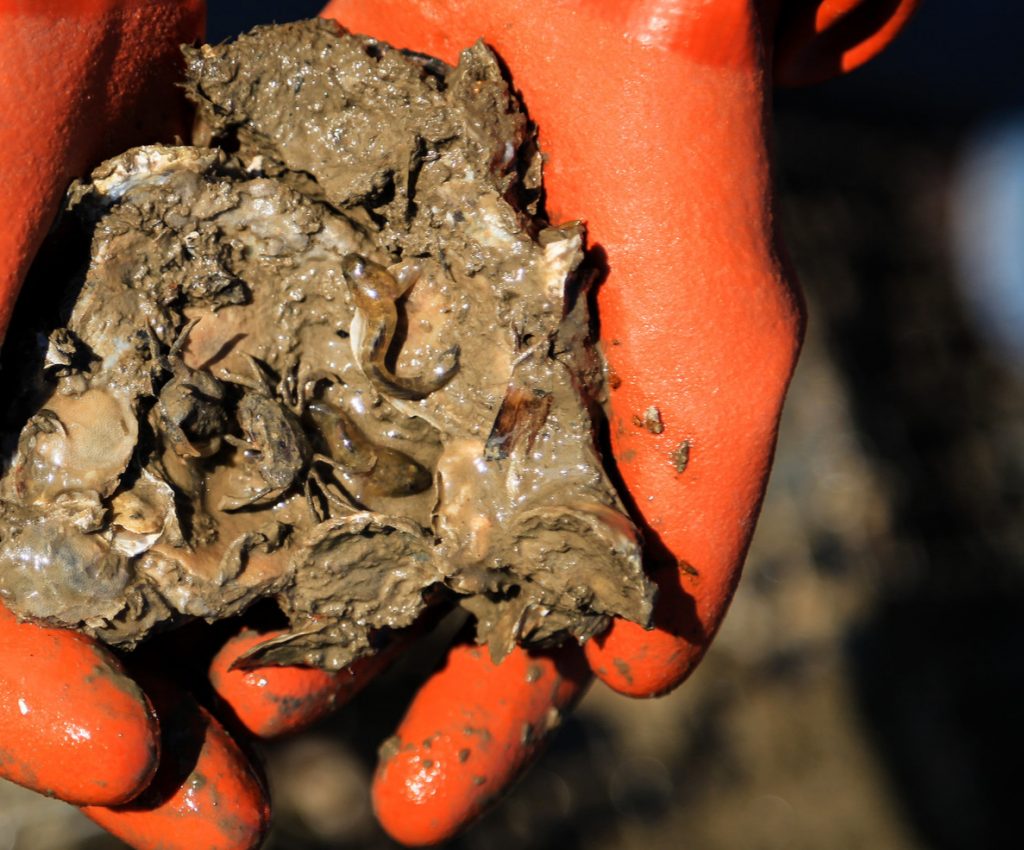
Oysters begin life as microscopic larvae that swim freely in the water before settling down on a hard surface such as rock or older shells. Now known as spat, the oysters grow into adults and fuse together into large reefs consisting of thousands of individuals. The complex three-dimensional reef structures provide essential habitat for a vast range of marine flora and fauna.
Species like mussels, barnacles, and sea anemones settle on reefs, establishing abundant food sources for fish species important to recreational and commercial harvest. Species like oyster gobies and blennies lay their eggs inside dead oyster shells to conceal them from predators. Most importantly, the innumerable nooks and crannies in an oyster reef provide shelter for marine critters, which is especially essential for juveniles in need of hiding places.
Life is not easy for baby fish and invertebrates, but oyster reefs help by buffering temperature extremes and by providing shelter from hungry predators. The presence of these organisms then attracts larger predators which in turn attract even larger predators, and in this way an oyster reef establishes its own complex and self-sustaining ecosystem. For aquatic critters, an oyster reef can be like an oasis in the middle of a desert.
Also among the many environmental benefits of the oyster is its effectiveness as a natural breakwater – in fact, it is more effective than artificial methods. Whereas artificial breakwaters like solid seawalls only deflect wave energy, potentially just passing the problem down the coast, oyster reefs dissipate the wave energy. And unlike artificial methods, an oyster reef grows and changes naturally, allowing it to keep pace with sea level rise.
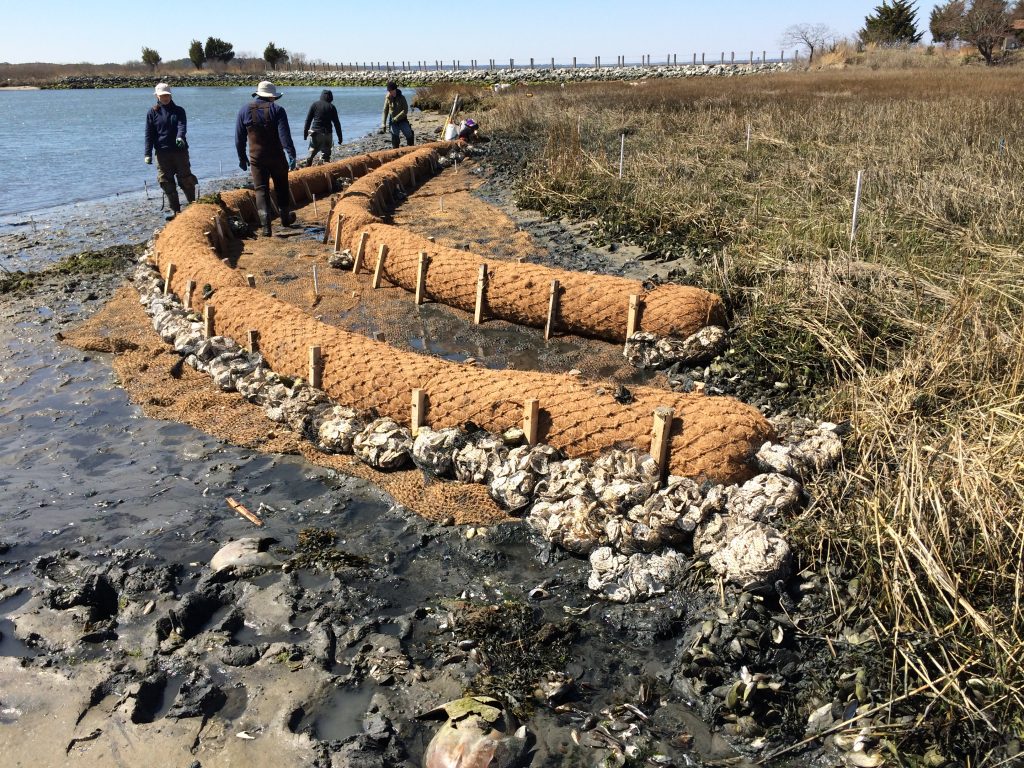
The effectiveness of a reef depends on many factors including its size and orientation, but under ideal conditions, an oyster reef will reduce up to 90% of wave energy. Oyster reefs can be especially valuable as natural breakwaters in areas where high boat traffic intensifies shoreline erosion.
The resulting calmer waters support the growth of coastal marshes and seagrass beds, which can then begin providing their own services to the ecosystem. This leads to a highly beneficial form of natural coastal and wetland protection, wherein multiple habitat types work together to maximize the benefits to the humans and animals that rely upon the coastal environment.
Oyster reefs are so essential to shoreline and wetland protection that empty shells are collected from restaurants and individuals by the Delaware Center for the Inland Bays and the Partnership for the Delaware Estuary. These organizations then stuff the shells into mesh bags that are placed along the edge of living shorelines projects. The resulting line of recycled shells then serves as the first line of defense for protecting the marsh edge from erosion by waves, and also as substrate on which new oyster reefs may form.
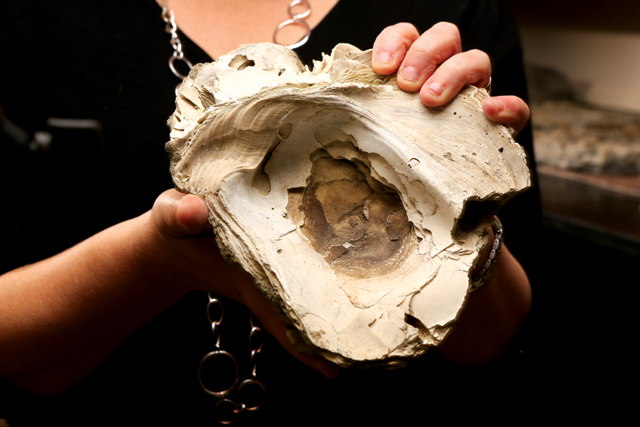
In the early 1600s, when Captain John Smith explored our region, he wrote that the oyster reefs were so numerous that the ship had to carefully navigate around them. Unfortunately, today oyster levels are at historic lows in the Delaware region and in other areas along the US coasts. By the mid-20th century, a conspiration of overharvesting, oyster diseases, and habitat degradation had devastated oyster populations, which have been having trouble recovering ever since.
Today, oyster populations are showing some hopeful signs, but the news remains mixed. As a keystone species, the devastation of oysters has resulted in waters that are murkier and more frequently anoxic, loss of important habitat, and erosion of shorelines and marsh.
Fortunately, just as the loss of oysters results in great harm to other species, the reintroduction of oysters can help those species recover. Oyster restoration is a top priority of many environmental organizations because the ecosystem services provided by oysters are so significant, varied, and long-lasting. Not to mention, oyster restoration efforts are often more cost-effective and technologically simpler than other types of projects.
Last year, the first oysters grown in the Inland Bay’s new shellfish aquaculture program were harvested and enjoyed at Delaware restaurants. Rather than being harvested from wild reefs, these oysters are grown from seed in cages. Oyster farmers lease acres of the Inland Bays from the State of Delaware, then tend to the oysters as they grow from seed the size of small pebbles to adult oysters that are then enjoyed in raw bars in Delaware and beyond.
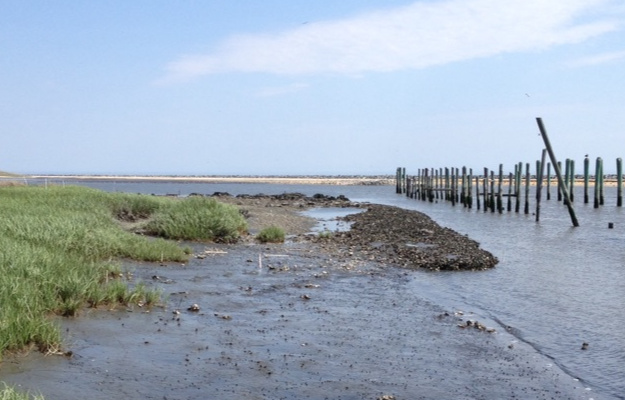
Oyster farming is sustainable, benefitting the ecosystem by replicating the environmental services once provided by great natural oyster reefs. They filter the water of the Inland Bays, which have long suffered from excess levels of nutrients and sediments that are preventing remnant seagrass beds from expanding. They provide three-dimensional structure, transforming the flat, featureless bottom typical of the Inland Bays into complex habitat that attracts a variety of important and threatened species. In this way, they serve as replacement habitat for the seagrass beds that were once ubiquitous in bays up and down the coast, and oyster farmers have been amazed at the huge variety of critters they find in and around their cages. And the aquacultured oysters help reduce the marsh erosion, important considering the high boat traffic common in the Inland Bays.
Oyster farmers take great care to keep their products safe for enjoyment by healthy consumers. As oysters filter feed, they remove not only food particles from the water, but also naturally-occurring pathogens, which are then concentrated at rates higher than the surrounding water. As a consequence, persons with certain medical conditions should never consume oysters unless thoroughly cooked, but raw oysters are nutritious and delicious for healthy persons. DNREC works with oyster farmers to enforce regulations for shellfish harvesting and handling to prevent shellfish-borne illness.
It is hoped that the new oyster aquaculture program, along with oyster restoration efforts being spearheaded by several organizations, will help restore our state waters and wetlands through the oyster’s tremendous capacity for filtering water, providing habitat, and preventing shoreline erosion. Truly, oysters are amazing environmental warriors with a keystone role in ensuring that ecosystems stay healthy for the benefit of a range of plants and animals which includes, of course, you and me!
Written on: March 13th, 2020 in Outreach, Wetland Restorations
Guest writer: Kelly Valencik, DNREC Delaware Coastal Programs

Many communities throughout our state have already seen changes as a result of climate change- from shifting rainfall and storm patterns, to increased drought, to flooding from sea level rise. These consequences of the warming earth and ocean temperatures as a result of greenhouse gas emissions have brought long term community planning challenges to Delaware.
For example, residents in the City of Lewes, which sits next to the Delaware Bay in Sussex County, have noticed more and more disruptions to the typical rhythms of nature in their community. Now it’s not just the the big coastal storms or nor’easters that cause flooding issues, it is also the sunny day, strong or spring tides that are inundating sections of main roads that connect the downtown area to the major road arteries.
Other Delaware communities have experienced similar issues and and are looking for ways to tackle these problems now before they get worse, with the ultimate goal to reduce impacts to their residents.
The Delaware Department of Natural Resources and Environmental Control (DNREC) wants to assist municipalities and communities across the state in becoming more prepared and resilient to any change that currently appears inevitable.
Community resilience is the ability to plan for and bounce back quickly from hazardous events. In the coastal context, the focus is on planning for more frequent and stronger storms, sea level rise, and other changing climate conditions so that communities are better able to recover when the event occurs.
Communities and local governments in Delaware have the opportunity to be proactive and play a leading role in preparing and responding to the impacts of severe weather and climate change because municipalities largely have the responsibility for planning their own future through land use decisions, building codes and design, and maintenance of infrastructure such as water and wastewater systems. Using these tools, municipalities can be vigilant in protecting and safeguarding people and habitats from harm.
Green infrastructure is a nature-based approach to address environmental challenges such as stormwater runoff, coastal flooding, erosion, and water and air pollution. It uses natural processes to manage water and improve environmental quality. These natural processes include using plants and soils to:
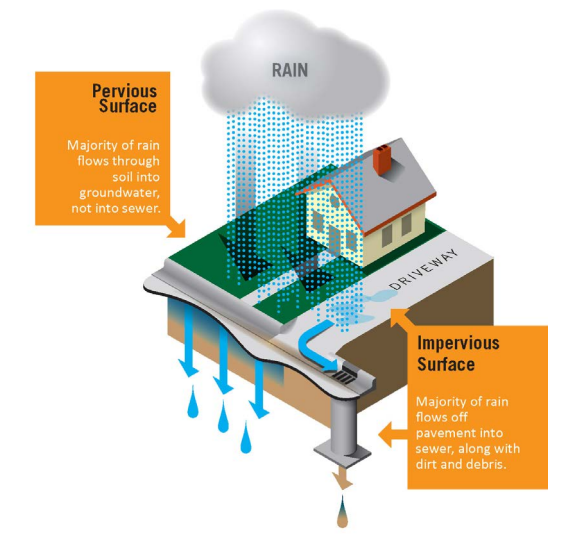
Stormwater refers to the rainwater that flows off of different surfaces after it falls to the ground. People commonly see stormwater running out of rooftop gutters and along the sides of streets during a rainstorm. The surfaces on which rainwater falls are classified into two categories:
When land is developed, pervious surfaces (water infiltrating) are replaced with impervious surfaces (solid) which allows for a larger volume of stormwater to run off into storm drains and streams. This can cause more frequent flooding and can make coastal flooding or sea level rise inundation worse. In developed areas, stormwater is also more likely to pick up pollutants like gasoline residue, animal waste, and trash and carry them into streams, bays, and the ocean.
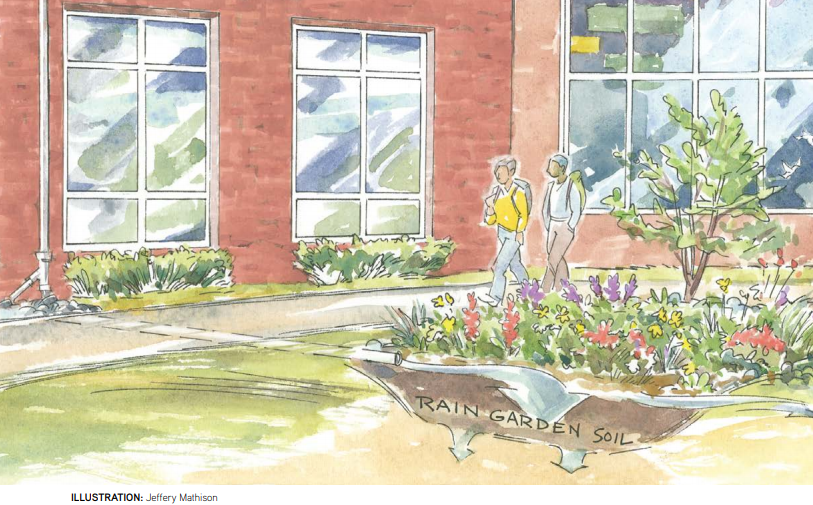
Communities are working to improve their resiliency through the use of Best Management Practices (BMPs) to capture runoff from impervious areas, reduce flooding, and filter pollutants out of stormwater before it reaches important aquatic ecosystems, like wetlands, or recreational areas. Green infrastructure can be used in many different settings to act as a BMP that improves stormwater management and the infiltration of runoff.
For example, trees can be used in urban, suburban, and rural settings, in plantings of one or two trees, or in a 100-foot-wide forested buffer along a river shoreline. Their root systems help absorb precipitation and filter water runoff before it reaches open bodies of water. Rain gardens can act in similar way and help manage stormwater runoff from specific areas such as roofs and parking areas, while larger expanses of conserved or restored wetlands can provide flood retention, carbon storage, and wildlife habitat.
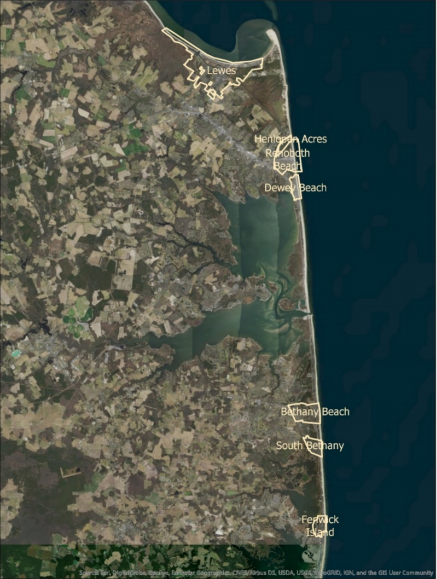
Last year the DNREC Delaware Coastal Program’s (DCP)’s Resilient Community Partnership (RCP) program worked with a group of coastal municipalities, the Cities of Lewes and Rehoboth, and the Towns of Henlopen Acres, Dewey Beach, Bethany Beach, South Bethany, and Fenwick Island, to conduct a study of impervious surface coverage. This study was done to find out what impacts the existing impervious surfaces in these cities and towns have on the stormwater management of precipitation and water quality.
These coastal communities face challenges on multiple fronts for addressing stormwater management including: tidal flooding, rapid population growth from tourism and development, a shallow groundwater table, and growing floodplain. The best path forward to consider all of these challenges to plan for their resident’s futures, was for all 7 of these communities to work together to gain an understanding of existing impervious surfaces and strategies for reducing said coverage.
Three components to this project were performed to address these multiple influences on stormwater management.
Many of the recommendations from this plan include methods of using green infrastructure at the municipal (or citywide level) and residential levels, and are now being considered for adoption in these communities. As a result, these communities are better prepared to react to address flooding and sea level rise concerns and have community specific nature-based solutions easily accessible to reduce the impact of impervious surfaces on their environment and water quality.
Written on: March 6th, 2020 in Wetland Assessments

Guest Student Writer: Catherine Medlock, Graduate Student of University of Delaware
In tidal marshes, accurate representation of marsh elevation or height is critical for understanding sea-level rise, tidal inundation, and storm surge. Small changes in marsh elevation can significantly change the water movement (hydrology), plants (vegetation), and habitat. Our study aims to look at and correct a remote sensing method known as light detection and ranging (LiDAR), in order to provide accurate elevation data to scientists and coastal managers in Delaware.
LiDAR may sound complicated, but it is really quite simple. LiDAR uses light pulses emitted from a sensor to gather 3-dimensional information about the earth’s surface. The LiDAR data is delivered as a 3-D cloud of individual points representing the ground, trees, buildings, and power lines. Ground elevation points are extracted from the point cloud, which are then used to create a digital map of the surface elevation called a digital elevation model (DEM). LiDAR is used in many coastal applications due to its high accuracy and density of data over large areas. For reference, in one square mile, LiDAR can collect over 7 million points!

LiDAR was collected across the entire state of Delaware in early 2014. LiDAR is an incredibly useful tool for topographic mapping, flood risk management, shoreline mapping, precision agriculture, and forest planning and management. Unfortunately, in tidal marshes, the light pulses are unable to penetrate through the dense vegetation to reach the marsh surface. This results in an average overestimation of 9 to 25 cm in elevation between the DEM and the actual marsh surface, depending on the marsh vegetation. This error can in turn lead to underestimations in the extent of coastal flooding and potential marsh erosion.
The goal of our study is to reduce the vertical error of LiDAR for mosquito ditches and the marsh platform, and provide a DEM correction that can be applied to all tidal marshes in Delaware. Four watersheds were identified to test several LiDAR correction methods: Blackbird Creek, Murderkill River, Leipsic River, and the St. Jones River. Over several years, we collected over 1000 GPS measurements with centimeter (cm)-level accuracy across the four marshes to compare DEM elevations with actual marsh elevations, and aid in the DEM corrections. As a result of the study, we plan to produce corrected DEMs, in order to model tidal inundation and assess marsh vulnerability in Delaware’s coastal marshes.

Historic human activities in marshes further complicate DEM corrections. In the 1930’s, the civilian conservation corps (CCC) dug mosquito ditches across marshes in Delaware to reduce mosquito populations by draining shallow pools on the marsh surface where mosquitoes reproduce. Enhancing drainage of the marsh surface actually transformed historically low salt marsh into high salt marsh habitat. Mosquito ditches are extensive throughout Delaware, and still visible in imagery today!
Mosquito ditches have a different elevation and vegetation than the rest of the marsh, so they require their own separate DEM correction. In efforts to correct the DEM for both the marsh platform and mosquito ditches, we hope to gain a better understanding of marsh inundation and vulnerability, and provide a useful tool to aide coastal scientists and managers in preparing for future environmental changes in Delaware’s marshes.
Written on: March 5th, 2020 in Outreach

by Kenny Smith, DNREC Wetlands Monitoring & Assessment Program
Man-eating plants are a thing of sci-fi movies, they will send vines out to capture you or leap at you and consume you but back in the real-world carnivorous plants are a real thing. Our world consists of more then 600 known species of carnivorous plants that use varying tactics to capture and digest their prey1. These plants mostly consume insects but on occasion can consume small mammals, amphibians, fish, and even birds if the opportunity presents itself.
Carnivorous plants use a trapping mechanism which consists of a modified leaf that draws prey into the plant. The mechanism could be in the form of a hollow leaf with liquid to passively collect and digest prey or it could be an active trap that rapidly closes its modified leaves to catch prey. The plant then relies on bacteria or enzymes to breakdown the prey into usable nitrogenous compounds and salts1.
While these plants are carnivorous most of them still create food by photosynthesis, like other plants. The meat-eating habit or adaptation supplements the diet to counteract the poor soil and environment in which they live. Most of these plants are found in wetlands or open water environments where the nutrients available are low.
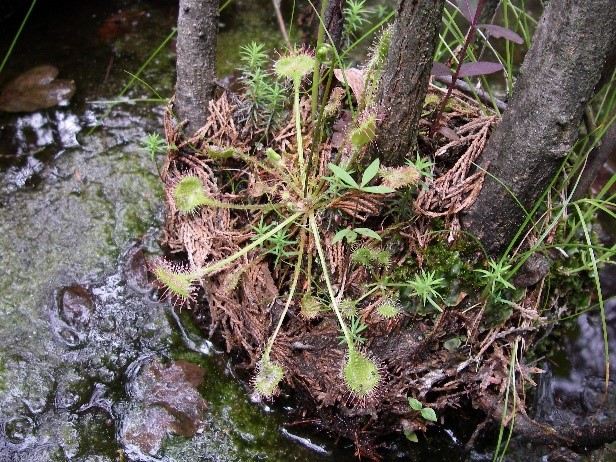
Delaware is home to 17 different species of carnivorous plants contained in 3 families; these are sundews, bladderworts, and pitcher plants. Of these 17 species, 4 species have not been found in Delaware for over 20 years and 6 species are considered extremely or very rare in Delaware2. Many of these plants are in danger of being lost due to habitat loss and over-collection3.
Read below to learn a little more about these interesting and unique plants.
There are about 152 sundew species throughout the world. Delaware is home to 4 of them, with only 2 of them found in state in the last 20 years. The Spoon-leaved Sundew (Drosera intermedia) is the most common sundew while the Roundleaf Sundew (Drosera rotundifolia) is a very rare species in Delaware2.

Both of these species are a perennial plant that can be found in Atlantic white cedar swamps, which are a unique wetland type in Delaware. Sundew species generally can survive better than other carnivorous plants in response to disturbance, which makes them one of the hardiest plants of the carnivorous plant group4.
Sundews have leaves covered in stalked glands that ooze sticky mucus. Sundews get their name from the sticky mucus appearing to glisten in the sun like a morning dew. After prey is trapped on the sticky hairs the edges of the leaves roll up to enclose the prey.
The bladderwort genus is the most diverse and widespread of all carnivorous plants with 220 species that range from temperate to tropical habitats. Although Delaware is home to 12 bladderwort species, 4 of these species are considered extremely or very rare in our landscape. The Purple Bladderwort (Utricularia purpurea) and the Not-fused Swollen Bladderwort (Utricularia inflata) are the states rarest bladderwort species 2 .
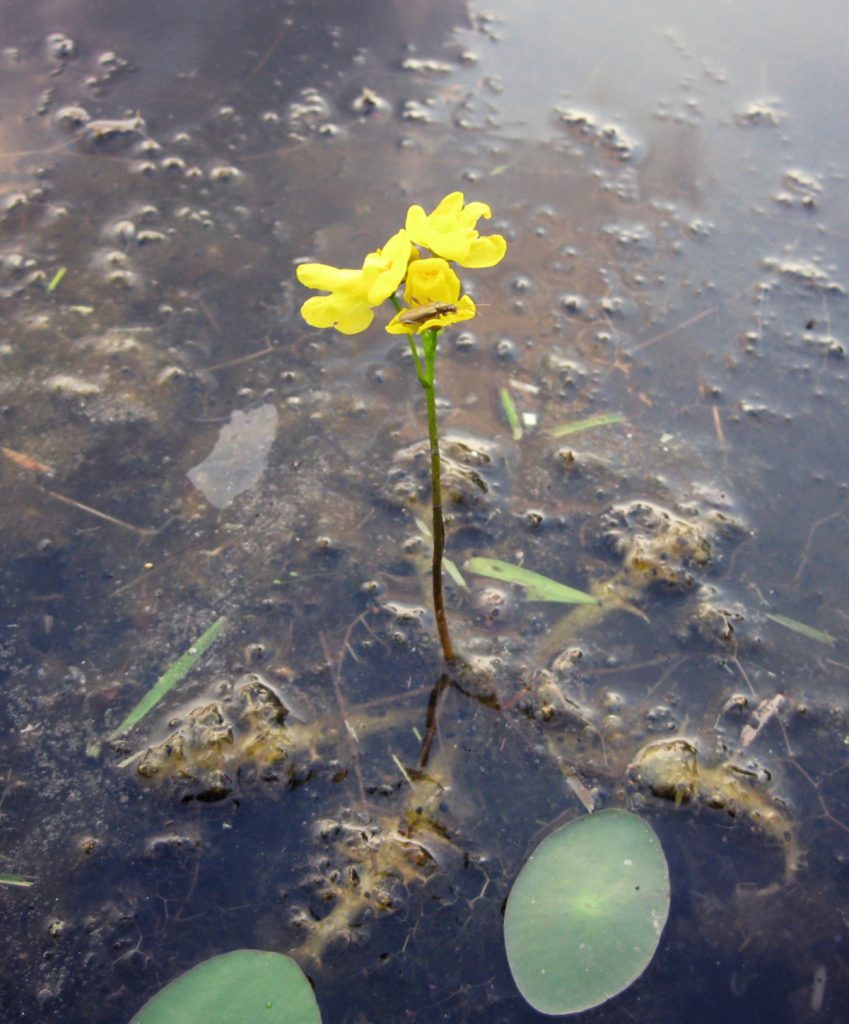
Bladderworts are usually found in open water and are an aquatic perennial plant. Bladderworts use a suction type trap. They have bladders that sit under water which contain tiny hairlike projections at the opening. When a passing prey stimulates these hairs, the plant will suddenly inflate the flattened bladder which sucks the prey in, and close a trap door to prevent escape.
Very similar to most aquatic plants that live in a climate with a cold winter they have to prepare. Bladderworts do so by creating a special bud-like structure called a turion that sinks to the bottom and awaits for warmer weather. This turion contains a mass of nearly formed leaves on a stem that has not elongated yet. This mass forms and grows in response to decreasing day-length.
Pitcher Plants can be found throughout the world but Delaware only has one species, the Northern Purple Pitcher plant (Sarracenia purpurea)2. This species is extremely rare in Delaware and can be found in Atlantic White Cedar swamps, which also happens to be a state unique and rare wetland type.
Based off the name you could guess that this plant uses a pitcher or pitfall trap to harvest prey. This pitcher mimics flowers with its coloring and puts off decaying smells of previous victims to attract flies and other insects looking for food. Once the prey enters the pitcher, they are met with a waxy surface leading to a pool of water. To prevent the insect from simply flying away, the plant supplies a wetting agent that sticks to the insect’s wings keeping it grounded3.
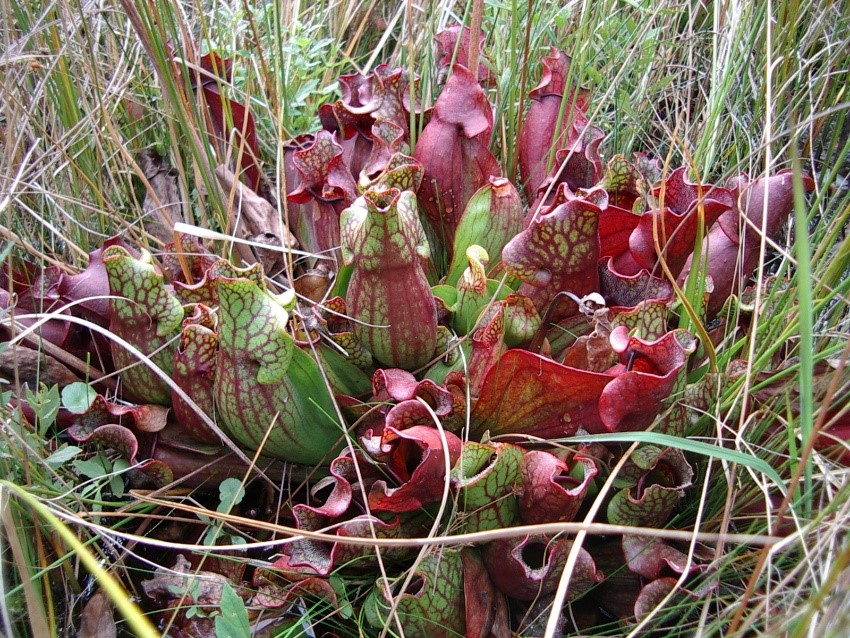
Once the meal is trapped, the pitcher plant has a couple of mechanisms to digest their food:
While the plant relies on prey falling into the leaves and decaying, many animals use the pitcher plant to fulfill a life cycle phase, like the larval stage of mosquitoes, or some frogs have been found to sit in the pitchers and consume the insects that the plant attracts.
1The Editors of Encyclopedia Britannica. “Carnivorous Plant” Encyclopedia Britannica, Encyclopedia Brittannica Inc., 18 Oct 2017, https://www.britannica.com/plant/carnivorous-plant
2McAvoy, W.A. and Bennett, K.A. The Flora of Delaware: An Annotated Checklist. Delaware Department of Natural Resources and Environmental Control, 2001
3” Carnivorous Plants/Insectivorous Plants.” Carnivorous and Insectivorous Plants Online, Drosera (Sundew), Utricularia (Bladderworts), and Sarracenia (Pitcher Plants). Botanical Society of America, https://botany.org/Carnivorous_Plants/
4Drosera Rotundifolia, Fire Effects Information System (FEIS), United States Forest Service, https://www.fs.fed.us/database/feis/plants/forb/drorot/all.html
Written on: March 5th, 2020 in Living Shorelines, Outreach, Wetland Restorations
by Erin Dorset, DNREC Wetlands Monitoring & Assessment Program
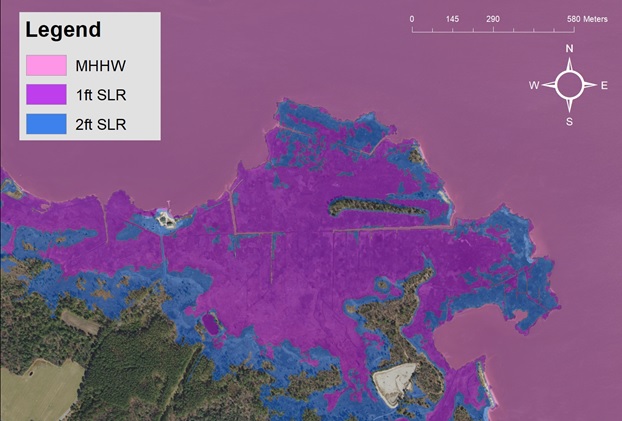
If you’re in the world of wetlands, sea level rise is a common topic of conversation. For example, here on our blog, we’ve talked about long-term monitoring efforts relating to marsh resilience in the face of rising seas and about saltwater intrusion into forested freshwater wetlands. We’ve also had a contributing author discuss effects of rising seas on trees near tidal marshes. However, sometimes we forget to stop and think about the reasons why we are experiencing sea level rise. So, let’s back up a little bit.
Sea level rise largely began with global warming, or an increase in Earth’s global temperatures. Global warming is caused by greenhouse gases absorbing and trapping solar radiation, which warms the planet more rapidly than would occur naturally. As global temperatures have risen, massive ice sheets and glaciers in Greenland and Antarctica have begun to melt rapidly, increasing sea levels. Plus, as ocean waters get warmer, they expand, further raising water levels on a global scale.
Although it is happening around the world, there are some spots that are being affected more than others. The Mid-Atlantic Coast—including Delaware—is experiencing one of the highest rates of sea level rise in the U.S, second only to the Gulf Coast.
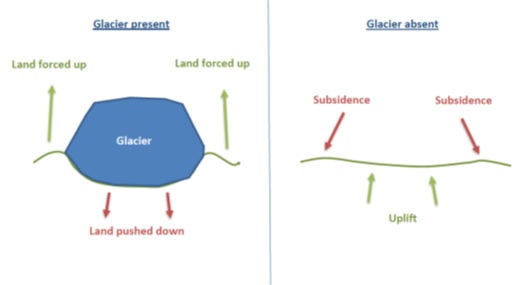
Thousands of years ago, when glaciers covered much of North America, land that was just outside of the glacial footprint—such as the Mid-Atlantic region—was forced upward as the glaciers pressed down on the land they resided upon. Once the glaciers were gone, pressure was lifted, and the land that had been forced up began to slowly sink down again. That process, called glacial isostatic adjustment, is still happening in the Mid-Atlantic today. As the land sinks, or subsides, sea levels rise even more.
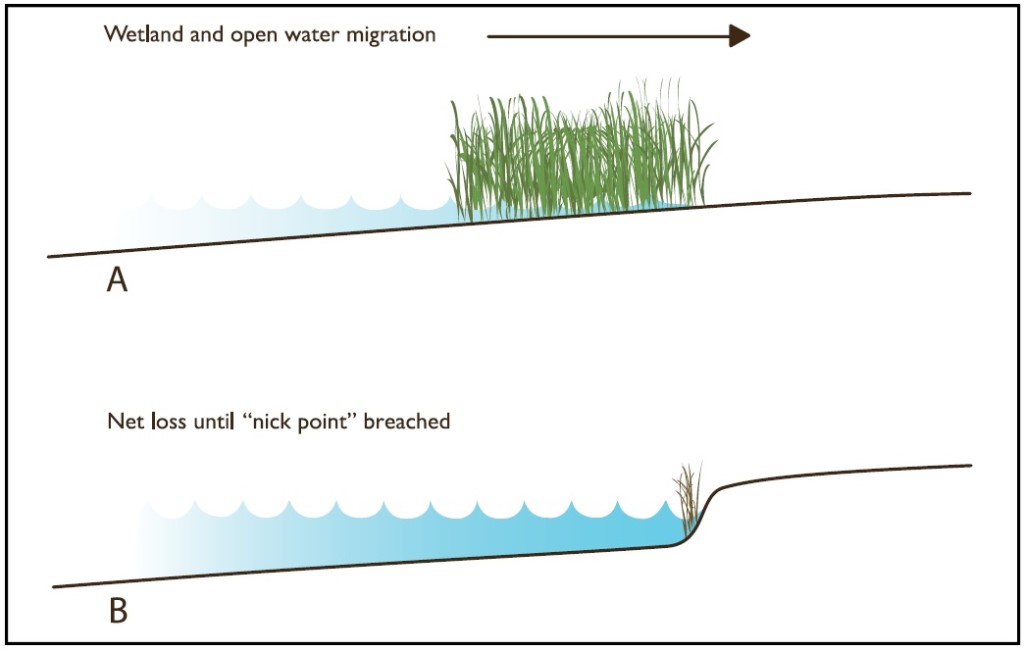
Tidal wetlands have the amazing ability to gain elevation (or height) in nature. When marsh plants die, they pile up on the marsh surface and decompose slowly, while live plants help trap and keep sediments in place and out of the water. Unfortunately, sea levels are rising too quickly in the Mid-Atlantic for many wetlands to keep up. This can result in a couple of different scenarios:
As bleak as this outlook may sound, there is hope, too. As previously mentioned, some Mid-Atlantic wetlands might be able to keep up with sea level rise by naturally gaining enough height or elevation, while others may be able to migrate inland. In places where that is not the case, scientists and land managers are looking into other ways to save or restore tidal wetlands wherever possible and make them more hardy in the face of sea level rise. A couple of these projects include:
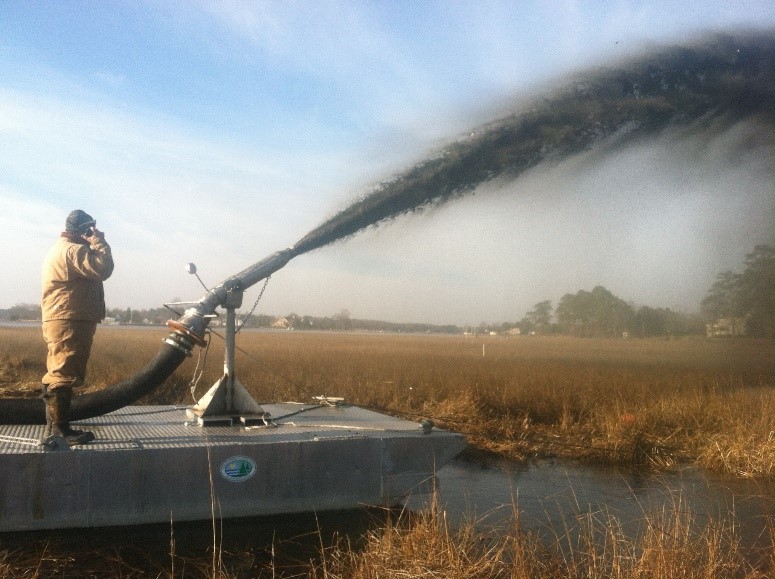
This strategy involves using dredge material to increase elevation of struggling tidal marshes to an elevation that is optimal for plant growth, which makes them more stable. Beneficial use can also be used to rebuild marshes that have been lost completely from erosion and sea level rise. See a Delaware example!
Tidal shorelines that are suffering from erosion can become stronger by using nature-based materials, such as coir logs, coir matting, and oyster shells. Look at one of the latest Delaware examples!
By incorporating the latest sea level rise projections for the Mid-Atlantic into these kinds of projects, professionals can help put our best foot forward to help coastal wetlands in our region.